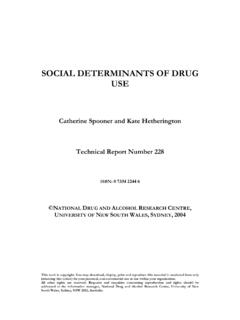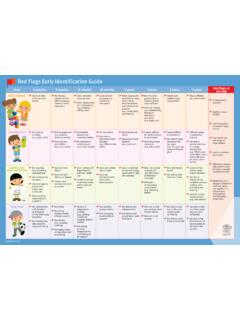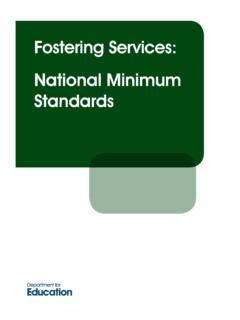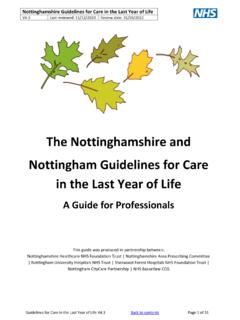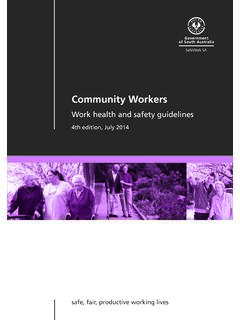Transcription of A comprehensive assessment
1 Saksuicide assessment kitA comprehensive assessment & policy development package NATIONAL DRUG AND ALCOHOL RESEARCH CENTRE, UNIVERSITY OF NEW SOUTH WALES, SYDNEY, 2015 Suggested citation: Deady, M., Ross, J. & Darke, S. (2015). Suicide assessment Kit (SAK): A comprehensive assessment and policy development package. Sydney: National Drug and Alcohol Research Centre. Funding Acknowledgement: The development of the Suicide assessment Kit (SAK) was funded by the Australian Government Department of Health. Grant: Ross, J. & Darke, S. (2010) Suicide risk assessment and intervention strategies: current practices in Australian residential drug and alcohol treatment settings (stage 2) Legal disclaimer This document is a general guide to appropriate practice, to be followed only subject to the practitioner s judgement in each individual case.
2 The Kit is designed to assist decision making and is based on the best information available at the date of publication. Contents i Preface .. ii Introduction .. iii 1. Staff Resources .. 1 Suicide Risk Screener .. 2 Aims of the Suicide Risk Screener .. 2 When to complete the Suicide Risk Screener .. 2 Suicide Risk Screener .. 3 Instructions .. 5 How to complete the Suicide Risk Screener .. 5 How to score the Suicide Risk Screener .. 7 Suicide Risk Formulation Template .. 10 Aims of the Suicide Risk Formulation Template .. 10 When to complete the Suicide Risk Formulation Template .. 10 Client Care Plan .. 13 Instructions.
3 14 How to complete the Suicide Risk Formulation Template .. 14 Risk factors included in the Suicide Risk Formulation Template .. 14 Client strengths relevant to treatment .. 15 2. Supporting Documents For 17 Warning signs for suicide .. 18 Instructions .. 18 Warning Signs for Suicide .. 20 Keep Safe Strategies .. 22 Instructions .. 22 Keep Safe Strategies .. 23 Safety Planning .. 25 Instructions .. 25 Safety Plan .. 26 Safety Plan on Exit .. 27 Commitment to Treatment .. 30 Instructions .. 30 Commitment to Treatment .. 31 3.
4 Manager Resources .. 32 Suicide Policies and Procedures Pro-Forma .. 33 Aims of the policies and procedures pro-forma .. 33 Structure of the policies and procedures pro-forma .. 33 Instructions .. 33 Suggested process for developing policies and procedures .. 33 Suicide Policies and Procedures Pro-Forma .. 35 Suggested layout .. 35 i. Definitions .. 36 ii. Policies .. 37 a. Overarching principles .. 37 b. Roles and responsibilities .. 38 c. Confidentiality and duty of care .. 39 d. Documentation and record keeping .. 39 e. Consultation and referral .. 40 f. Timeliness of assessment .. 41 iii. assessment Procedures .. 42 a. Acute suicide risk screening.
5 42 b. comprehensive suicide risk assessment .. 42 c. Other issues to consider .. 43 d. Re- assessment .. 43 Figure 1: Potential guide to assessment procedure .. 44 iv. Management and intervention Procedures .. 45 a. Risk management .. 45 b. Referral procedure .. 45 c. Acute crisis care .. 46 d. Discharge and re-entry .. 46 v. Professional Development, Supervision and Support .. 47 vi. Review and evaluation .. 48 vii. Appendices .. 49 Appendix A: Onsite incident procedure .. 49 Appendix B: Bereavement .. 50 Appendix C: Special Populations .. 51 4. Supporting Documents For managers .. 52 SAK integration checklist .. 53 Feedback from a Service Director on implementation of the SAK.
6 56 Memorandum of 57 Instructions .. 57 Memorandum of Understanding .. 58 Executed as a Memorandum of Understanding .. 63 Referral Guidance .. 64 Instructions .. 64 Letter of 65 Client identification Information Sheet .. 66 References .. 67 Glossary Alcohol and/or other drug (AOD) use disorders the presence of abuse or dependence on AOD as defined by the commonly accepted classification systems, such as the Diagnostic and Statistical Manual (DSM) of Mental Disorders and the International Classification of Diseases (ICD).
7 This term is used interchangeably with substance use disorders and includes substance abuse and substance dependence. AOD treatment services refers to specialised services that are specifically designed for the treatment of AOD problems and include, but are not limited to, facilities providing inpatient or outpatient detoxification, residential rehabilitation, substitution therapies ( , methadone or buprenorphine for opiate dependence), and outpatient counselling services. These services may be in the government or non-government sector. AOD workers refers to all those who work in AOD treatment settings in a clinical capacity.
8 This includes, but is not limited to, nurses, medical practitioners, psychiatrists, psychologists, counsellors, social workers, and case workers. Mental illness refers to the presence of a mental health disorder (other than a substance use disorder) as defined by the DSM or ICD. Also known as psychopathology. comprehensive suicide risk assessment a comprehensive evaluation of a client s level of suicide risk. In addition to screening, the comprehensive assessment provides a thorough review of a range past and present factors. Safety plan a plan devised with client that includes intervention and reassessment and a particular course of action they can follow when the risk of suicidal behaviour is heightened.
9 The safety plan will detail who the client can contact for support, including family, friends, carers and service providers. Involve client and their families/ carers where possible in this process. Self-harming behaviour the direct, deliberate act of harming one s body without the conscious intention to die. Self-harm may result in death and is a risk factor for suicide. Suicidal ideation thoughts of engaging in suicidal behaviour, with or without a specific plan. Suicide self-injurious act intended to end one s life which results in death. Suicide attempt potentially self-injurious act intended to end one s life, but which does not result in death.
10 Suicide plan individual strategy for suicide inclusive of timeframe and means to complete suicide. Suicide risk screening the process of briefly ascertaining a basic overview of a client s suicide risk status (often through use of a standardised screening tool). i Preface The Suicide assessment Kit, or SAK , was developed by the National Drug and Alcohol Research Centre (NDARC) in partnership with the Network of Alcohol and Other Drug Agencies (NADA), and aims to provide alcohol and other drug (AOD) workers with evidence based resources to assist them in the assessment and management of suicide risk.




